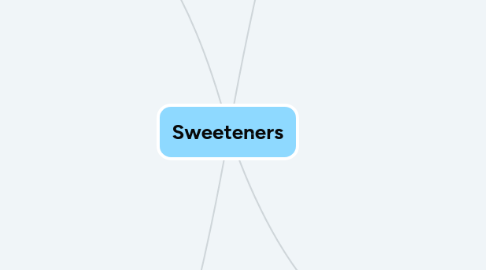
1. Nutritive Sweetener
1.1. Caloric
1.1.1. Sucrose
1.1.1.1. Known as table sugar
1.1.1.2. Dissacharides : Glucose + fructose
1.1.1.3. Produce from sugar cane or beet
1.1.2. Molasses
1.1.2.1. Byproduct of the sugar-making process
1.1.2.2. The thick syrup that's left behind after sugar cane juice boiled
1.1.3. Honey
1.1.4. Maple syrup
1.1.5. Barley syrup
1.1.6. Corn syrup
1.1.7. Starch derived sweetener
1.1.7.1. Glucose
1.1.7.2. Fructose
1.2. Low caloric
1.2.1. Sugar alcohols
1.2.1.1. Monosaccharides
1.2.1.1.1. Erythritol
1.2.1.1.2. Mannitol
1.2.1.1.3. Sorbital
1.2.1.1.4. Xylitol
1.2.1.2. Disaccharides
1.2.1.2.1. Isomalt
1.2.1.2.2. Lactitol
1.2.1.2.3. Maltitol
1.2.2. Tagatose
2. Function
2.1. As sweetening ingredient
2.2. Use in food preservation
2.2.1. Lowering water activity
2.2.2. Inhibit microbial growth and spoilage
2.2.3. eg : Jams, jellies
2.3. Use in food fermentation
2.3.1. In brewing & wine making
2.3.2. Help improve dough rheology by fermentation
2.4. Use in baking
2.4.1. Contribute to texture, tenderization and leavening
2.5. Food browning & caramelization
2.6. Lowering freezing point
2.6.1. eg : Ice cream, frozen dessert
3. Types
3.1. Nutritive (High intensity)
3.1.1. Posses a sweet taste but noncaloric
3.1.2. Have greater sweet taste than sugar, therefore used at very low levels.
3.1.3. Provide unique sweetness
3.2. Non-nutritive (Bulk)
3.2.1. Generally carbohydrates
3.2.2. Provide energy (calorie) to food
3.2.3. Have similar sweetness to sugar and used at comparable levels
4. Non-nutritive Sweetener
4.1. Synthetic, artificial
4.1.1. Hydrogenated starch hydrolyzates (HSH)
4.1.2. Derived through manufacturing of plant extracts or processed by chemical synthesis
4.1.2.1. Acesulfame ptassium
4.1.2.1.1. 200 times sweeter than sucrose
4.1.2.1.2. Crystalline, white powder
4.1.2.1.3. Has excellent solubility
4.1.2.1.4. Intense sweet taste on early onset but become bitter when at high level
4.1.2.2. Alitame
4.1.2.2.1. 2000 times sweeter than sucrose
4.1.2.2.2. Composed of
4.1.2.2.3. Has clean sweet taste
4.1.2.2.4. Has no unpleasant aftertaste
4.1.2.3. Aspartame
4.1.2.3.1. 200 times sweeter than sucrose
4.1.2.3.2. Consists of
4.1.2.3.3. Use to reduce calorie in food and beverages
4.1.2.4. Cyclamate
4.1.2.4.1. 30 to 50 times sweeter than sucrose
4.1.2.4.2. The least sweet of all artificial sweetener
4.1.2.4.3. Does not leave an aftertaste
4.1.2.5. Neotame
4.1.2.5.1. 7000 to 130000 times sweeter than sucrose
4.1.2.5.2. Consists of
4.1.2.6. Saccharin
4.1.2.6.1. 300 times sweeter than sucrose
4.1.2.6.2. May provide unpleasant taste aftertaste
4.1.2.7. Sucralose
4.1.2.7.1. Does not react chemically with other ingredients
4.1.2.7.2. Dissolves in clear liquids
4.1.2.7.3. Most heat-stable sweetener
4.2. Semisynthetic
4.2.1. Chemical modification
4.2.1.1. Neohesperidine dihydrochalcone
4.2.1.1.1. Extracted from citrus
4.2.1.1.2. When extracted, it become neohesperidin then undergo hydrolysis becomes a dihydrochalcone
4.2.1.1.3. Effective in masking bitter taste
4.3. Natural
4.3.1. Extraction from natural substances
4.3.1.1. Glycyrrhizin
4.3.1.1.1. Isolated from the roots (Glycyrrhizae Radix) of the plants Glycyrrhiza glabra
4.3.1.2. Stevioside
4.3.1.2.1. Found in the leaves of Stevia rebaudiana
4.3.1.3. Thaumatin
4.3.1.3.1. extracted from Katemfe fruit

